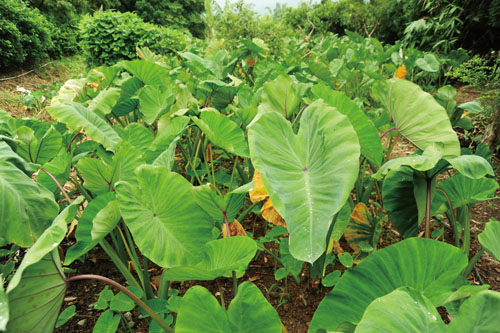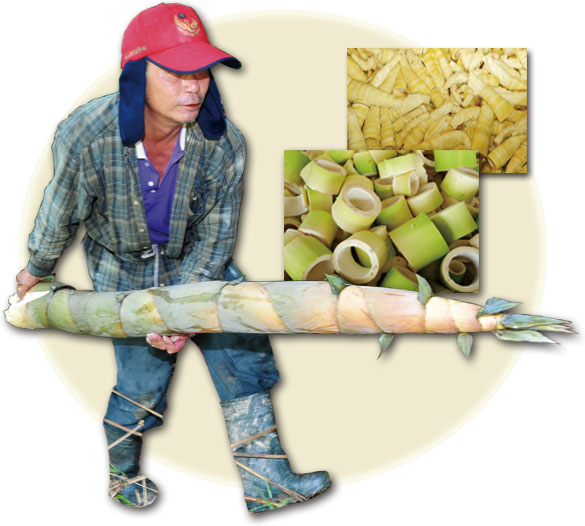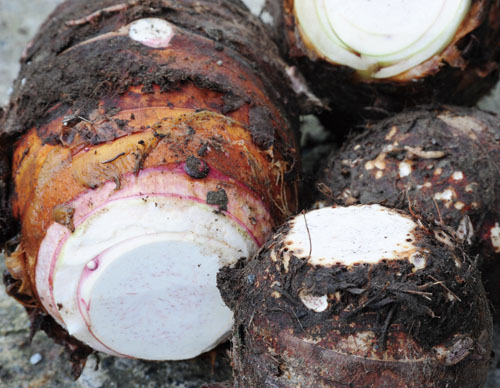The taste of autumn in Jiasian: Giant Bamboo Shoots and Taro/甲仙初秋鮮味 麻竹筍、芋頭
The taste of autumn in Jiasian: Giant Bamboo Shoots and Taro
◎English Translation: Peng Hsin-yi
◎Photos: Pao Chung-hui
Giant Bamboo Shoots
 It is 6 am and the bamboo forests are filled with farmers busy harvesting the bamboo shoots. Systematically, the farmers hew the tall stalks, slice the shoots and separate them from the hardened wood-like fiber part. The farmers then put giant bamboo shoots into piles according to size and ship them off to processing plants. Buyers come to buy in bulk and bid on the shoots after the fermentation stage has been completed.
It is 6 am and the bamboo forests are filled with farmers busy harvesting the bamboo shoots. Systematically, the farmers hew the tall stalks, slice the shoots and separate them from the hardened wood-like fiber part. The farmers then put giant bamboo shoots into piles according to size and ship them off to processing plants. Buyers come to buy in bulk and bid on the shoots after the fermentation stage has been completed.
The Latin name for this type of bamboo is Dendrocalamus latifloxus Munro. However since they are so tall, they are locally known as giant bamboo shoots. The farms take up about 2,000 hectares (4,942 acres) of Jiasian's land. Most of the farms are located in the hills which makes it difficult for the farmers to care for the shoots. The hills provide such good soil so that they do not need to use pesticides or fertilizers and produce excellent quality bamboo shoots.
Mr. Wang Cyuan-sheng has been a bamboo farmer for more than 30 years. He explains, bamboo shoots take 3 years to reach maturity. The forest requires no fertilizers, pesticide or herbicides, an extremely natural process. Mr. Wang describes the taste as complex and fresh, it is sweet, with a hint of bitterness. However, they are not suitable to eat as a fresh vegetable and are sold as cans of pickles and processed into a variety of other products.
Another farmer is Mr. Lu Jhong-yi, he describes Jiasian's bamboo shoots as being sold mostly in the domestic market. Jiasian is Taiwan's second largest supplier. He explains that it is important to boil the bamboo shoots for at least an hour in order to get rid of the bitter flavor and enhance the fragrance. Cooked bamboo shoots will turn a creamy yellow color, and the natural enzymes will kickoff the fermentation process; therefore, no seasonings or artificial flavors need to be added. The process takes approximately two weeks and with high temperatures and humidity, fermentation sometimes requires adjustment. Mr. Lu believes the most demanding part of the harvest is that it must be completed in one day or the taste and texture will quickly fade. Often during harvest season, farmers don't get to bed until well past midnight.
The fermentation produces a lactic acid bacterium which adds depth and complexity to the taste. The tips of the bamboo shoots are usually shredded into fine strings and are found in the canned goods section of supermarkets in Taiwan. The bottom part of the shoot contains thicker fiber and is either made into dried bamboo or used in prepackaged food products.
 Jiasian Taro: Unlike anywhere else
Jiasian Taro: Unlike anywhere else
Taro ice shops can be found on every corner in Jiasian. Jiashan is the home of a special type of taro known as Areca Heart. Maturing in 10 months, the harvest usually peaks after Mid-Autumn Festival (mid-September) and farms consume approximately 100 hectares (247 acres). However, they are having a hard time keeping up with demand so that people who want to try this unique treat must come to Jiasian.
Jiasian's land is rich in nutrients. The taro farms are located on its slopes which allows for good drainage and a great agricultural environment. The roots are ready to harvest when the leaves wither and fall off. Taro is shaped like an irregular oval and is much bigger than a potato or yam.  Once harvested, the land lies fallow for 2 to 3 years, in order allow for the regeneration of its fertility. The texture of Jiasian's taro roots is finely-grained and waxy. It can withstand a long cooking time and retains its shape. If the taro is cut at the cross section, it becomes clear the inside contains evenly distributed purple veins. Its starch leaves a white, powdery residue and has a unique fragrance. The diverse product can be used in savory dishes or desserts..
Once harvested, the land lies fallow for 2 to 3 years, in order allow for the regeneration of its fertility. The texture of Jiasian's taro roots is finely-grained and waxy. It can withstand a long cooking time and retains its shape. If the taro is cut at the cross section, it becomes clear the inside contains evenly distributed purple veins. Its starch leaves a white, powdery residue and has a unique fragrance. The diverse product can be used in savory dishes or desserts..
甲仙初秋鮮
麻竹筍、芋頭
◎文/林旻伶
◎攝影/鮑忠暉
八月,是甲仙地區農戶歡喜迎收穫的時節,接續進入採收期的兩大作物—麻竹筍、芋頭,各自以現採的新鮮滋味,或是風味十足的加工製品,吸引人們到甲仙一探究竟。
麻竹筍
清晨六點多,甲仙的筍農們早已展開一天的採收工作,筍農們手腳俐落地砍下一株株高如成人的麻竹筍,迅速剝去筍殼、露出黃綠色表皮,再將質地鮮嫩的筍管切成小段、淘汰已木質化的部位,依筍尖、筍管分門別類,一簍簍運送到當地的加工廠,經過殺青(水煮)、發酵等初級加工後,待價而沽。
甲仙的麻竹筍種植面積約有2,000公頃,受到山坡地影響,以種植「加工用」品種為大宗,每年七月底開始進入產季,一年約可收成兩個月。擁有超過30 年種植經驗的翁泉盛說,加工用麻竹筍口感爽脆,清甜中略帶苦味,栽種後至少需經過3年以上才能採收,不施肥、不噴灑農藥,是最天然的作物之一。
另一位筍農呂仲珆表示,甲仙麻竹筍以內銷市場為主,市佔率位居第二,麻竹筍進行初級加工時,先以水煮約一個小時,去除苦澀滋味,煮過的筍子香氣濃郁,色澤轉為淺黃,再移入大型發酵槽內,不添加任何人工調味料,自然發酵至少兩週,期間還得隨時注意溫度與濕度的變化。呂仲珆說,現採的麻竹筍必須當天處理,否則品質、口感都會大打折扣,在盛產季節,忙碌到半夜是家常便飯。
發酵完成的筍子自然產生乳酸菌,筍香更盛且微飄酸味。呂仲珆表示,較嫩的筍尖多半剝成絲狀,成為架上常見的竹筍罐頭;筍管部位則因纖維較明顯,適合製成筍干或調理包。
芋頭
 甲仙地區農會表示,當地芋頭品種為檳榔心芋,成長期約10個月,中秋節後才進入盛產期,種植面積約100公頃,品質極佳,總是供不應求,若想品嚐正港的甲仙芋頭,可得親自跑一趟。
甲仙地區農會表示,當地芋頭品種為檳榔心芋,成長期約10個月,中秋節後才進入盛產期,種植面積約100公頃,品質極佳,總是供不應求,若想品嚐正港的甲仙芋頭,可得親自跑一趟。
值得一提的是,甲仙芋頭生長於山坡地,收成後需休耕2至3年,讓土地休養生息。由於土壤肥沃且排水性佳,芋頭質地格外綿密軟Q,久煮不會化掉。當芋頭葉片自然枯黃掉落,便是採收時刻,熟成的芋頭外觀為橢圓形,內裡佈滿漂亮的紫紅色纖維,用刀削過,刀面上會留下白白的澱粉痕跡,那是新鮮美味的象徵,烹煮後芋香四溢,甜鹹口味皆宜。